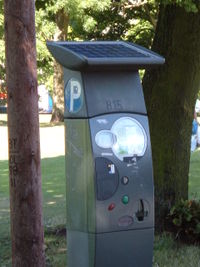Photovoltaic array
2007 Schools Wikipedia Selection. Related subjects: Engineering
A photovoltaic array is a linked collection of photovoltaic modules, one of which is shown in the picture to the right. Each photovoltaic (PV) module is made of multiple interconnected PV cells. The cells convert solar energy into direct-current electricity. PV modules are sometimes called solar panels, although that term better applies to solar-thermal water or air heating panels. Photovoltaic modules distinguish themselves from solar cells in that they are conveniently sized and packaged in weather-resistant housings for easy installation and deployment in residential, commercial, and industrial applications. The application and study of photovoltaic devices is known as photovoltaics.
PV cells operate via the photovoltaic effect which describes how certain materials can convert sunlight into electricity; they absorb some of the energy of the Sun and cause current to flow between two oppositely charged layers. Individual solar cells provide a relatively small amount of power, but electrical output can be significant when connected together. The cells, modules, and arrays can be connected in series or parallel, or typically a combination, to create a desired peak voltage output.
History
In 1839, during the Industrial Revolution, Alexandre Edmond Becquerel, father of the Nobel Laureate Henri Becquerel, discovered the photovoltaic effect which explains how electricity can be generated from sunlight. He claimed that "shining light on an electrode submerged in a conductive solution would create an electric current.". However, despite extensive research and developments after this discovery, photovoltaic power continued to be very inefficient. As such, photovoltaic cells were used mainly for the purposes of measuring light. Over 100 years later, in 1941, Russell Ohl invented the solar cell, following the invention of the transistor.
Applications
Solar photovoltaic panels are frequently applied in satellite power. However, costs of production have been reduced in recent years for more widespread use through production and technological advances. For example, single crystal silicon solar cells have largely been replaced by less expensive multicrystalline silicon solar cells, and thin film silicon solar cells have also been developed recently at lower costs of production yet (see Solar cell). Although they are reduced in energy conversion efficiency from single crystalline Si wafers, they are also much easier to produce at comparably lower costs.
Together with a storage battery, photovoltaics have become commonplace for certain low-power applications, such as signal buoys or devices in remote areas or simply where connection to the electricity mains would be impractical. In experimental form they have even been used to power automobiles in races such as the World solar challenge across Australia. Many yachts and land vehicles use them to charge on-board batteries.
PV performance
At high noon on a cloudless day at the equator, the sun delivers about 1 kW/m², on the Earth's surface, to a plane that is perpendicular to the sun's rays. As such, PV arrays should track the sun through each day to greatly enhance energy collection. However, tracking devices add cost, and require maintenance, so it is more common for PV arrays to have fixed mounts that tilt the array and face due South in the Northern Hemisphere. In the Southern Hemisphere, they should point due North. The tilt angle, from horizontal, can be varied for season, but if fixed, should be set to give optimal array output during the peak electrical demand portion of a typical year.
Other factors affect PV performance. Accounting for clouds, and the fact that most of the world is not on the equator, and that the sun sets in the evening, the correct measure of solar power is insolation: the average number of kilowatt-hours per square meter per day. For the weather and latitudes of the United States and Europe, typical insolation ranges from 4 KWh/m²/day in northern climes to 6.5 KWh/m²/day in the sunniest regions. Typical solar panels have an average efficiency of 12%, with the best commercially available panels at 20%. Thus, a photovoltaic installation in the southern latitudes of Europe or the United States may expect to produce 1KWh/m²/day. A typical "150 Watt" solar panel is about a square meter in size: such a panel may be expected to produce 1 KWh every day, on average, after taking account the weather and the latitude.
In the Sahara desert, with less cloud cover and a better solar angle, one can obtain closer to 83 W/m². The unpopulated area of the Sahara desert is over 9 million km², which if covered with solar panels would provide 750 terawatts total. The Earth's current energy comsumption is around 13.5 TW at any given moment (including oil, gas, coal, nuclear, and hydroelectric power).
Photovoltaic cells' electrical output is extremely sensitive to shading. When even a small portion of a cell, module, or array is shaded, while the remainder is in sunlight, the output falls drammatically due to internal 'short-circuiting' -- the electrons reversing course through the shaded portion of the P-N junction. As such it is extremely important that PV arrays not be shaded, at all, by trees, architectural features, flag poles, or other obstructions.
Module output and life are also degraded by increased temperature. Allowing ambient air to flow over, and if possible behind, PV modules reduces this problem. However, effective module lives are typically 20 years or so, so replacement costs should be considered as well.
Solar photovoltaic panels on spacecraft
Solar panels can be used on spacecraft, particularly when they are in the inner part of the solar system. They have been designed to pivot on spacecraft, so that they will always be in the direct path of solar rays. In order to optimise the amount of energy generated, solar panels on spacecraft can be equipped with a Fresnel lens, which concentrates sunlight. Because of these efforts to maximize electric production, and the fact that the Sun is mostly the only source of energy, the construction of solar cells on spacecraft could be one of the highest costs. When journeying to outer parts of the solar system (or beyond), nuclear reactors or radioisotope thermal generators are preferred, as the Sun's rays are too weak at such massive distances to power a spacecraft.
The ESA is researching the possibility of solar power satellites that would generate electricity in space and then beam it to Earth via laser or microwaves. In addition, solar power is being considered to be used as a propulsion mechanism in lieu of chemical propulsion.
Theory and construction
Crystalline silicon and gallium arsenide are typical choices of materials for solar cells. Gallium arsenide crystals are grown especially for photovoltaic use, while silicon crystals are available in less-expensive standard ingots. These ingots are produced mainly for consumption in the microelectronics industry. Polycrystalline silicon has lower conversion efficiency but also lower cost.
During the manufacturing process, crystalline silicon ingots are sliced into wafer-thin disks, polished to remove slicing damage, dopants are introduced into the soup, and metallic conductors are deposited onto each surface: a thin grid on the sun-facing side and usually a flat sheet on the other. Solar panels are constructed of these cells cut into appropriate shapes, protected from radiation and handling damage on the front surface by bonding on a cover glass, and cemented onto a substrate (either a rigid panel or a flexible blanket). Electrical connections are made in series or in parallel to determine total output voltage. The cement and the substrate must be thermally conductive, because the cells heat up from absorbing infrared energy that is not converted to electricity. Since cell heating reduces the operating efficiency it is desirable to minimize the heating. The resulting assemblies are called solar panels or solar arrays.




